How to Create a Remote Patient Monitoring Platform: a Provider's Guide
Updated 14 Mar 2024
18 Min
1595 Views
Remote health care of patients is increasing with the popularity of various kinds of medical IoT devices allowing for remote monitoring. However, managing and controlling such diversity is challenging without a proper digital solution.
To centralize and interconnect all the processes, hospitals, clinics, hospices, and physicians require a robust IT platform — Remote Patient Monitoring Software (RPM). Custom RPM systems enable patients’ vital sign tracking at a distance while reducing readmissions, automating routine tasks, optimizing expenses, and improving the quality of care delivery.
This article will outline the opportunities of remote patient monitoring software development for the healthcare industry, along with its types, essential components, and development pipeline.
How Is the Software Used In Remote Patient Monitoring?
Remote patient monitoring refers to the use of specific technologies and practices assisting medical providers in controlling real-time changes in a patient’s health data distantly and using it to personalize a treatment plan.
As a result, healthcare establishments have better control over healthcare costs, enhance care quality and outcomes, and reduce readmissions. This is significant for chronic disease management, facilitating access to care for the elderly, remote areas, and patients with mobility issues.
David Putrino
Director of Rehabilitation Innovation
What we know about remote patient monitoring and why it works is that when you are making more contact with a chronically ill individual, when you are watching them more closely, you pick up on things more easily.
Unlike other telemedicine delivery methods, RPM services do not demand video conferencing and virtual visits. Instead, they simply need specific-case technologies that gather, track, and interpret physiologic metrics.
Some ways to implement RPM for medical adherence include the set of following devices:
- Blood pressure monitor
- Continuous glucose monitor
- Anticoagulation testing device
- Heart rate monitors
- Pulse oximeter
- Smart scale
- Wireless patches that track medicine uptake
- Bioingestible sensor tablets that measure patient data
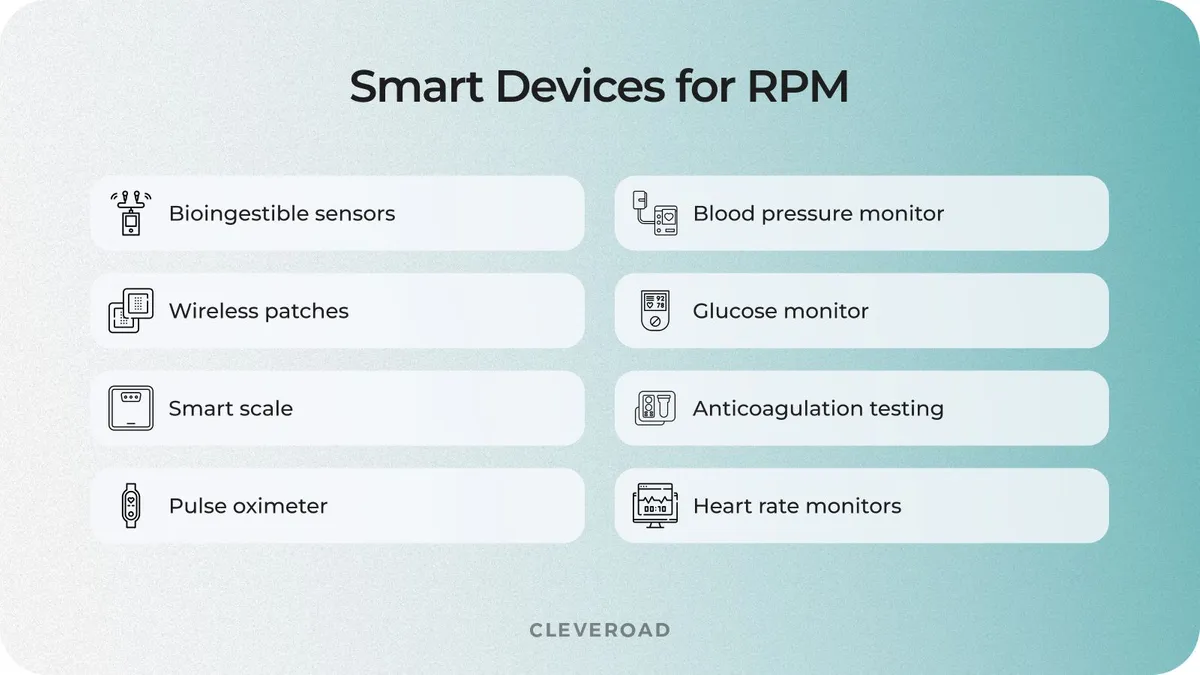
Examples of smart devices used with RPM software
However, with so many medical IoT devices available, there are common challenges all healthcare establishments face when it gets to delivering online medical services:
- How to make sense of all the patient health data coming from tons of different devices?
- How do we provide various systems interoperability?
- How do we ensure efficient switching between numerous devices and coordinate patient care?
- How to focus on multiple patients constantly?
Learn how to facilitate virtual communication between patients and healthcare providers with Patient Portal Development
This is why a robust custom RPM mobile app development is required. RPM software is a network of wearable and mobile devices strung together and connected to a central station. This intelligence solution will allow you to access, centralize, and manage all patient's health data acquired from multiple devices. By viewing and analyzing data trends over periods, medical staff will be able to make informed care decisions.
To further strengthen your decision to embrace remote patient monitoring software development, let’s see how exactly healthcare businesses can benefit from RPM solutions.
Improved patient engagement
Since remote patient monitoring solutions enable individuals to stay in touch with the care team 24/7, patients rein better control over their well-being by getting reminders to keep on course and follow the treatment schedule. For example, by implementing the RPM solution, the University of Pittsburgh Medical Center held patient satisfaction scores of over 90%. Also, healthcare facilities that decide to create remote patient monitoring app development can discover erratic patterns in patients' health and prevent complications by adjusting care plans on time.
Convenient access to data
Patient monitoring system software is designed to bridge the gap between care providers and patient health data. These solutions can be easily inserted into beds at home and in hospitals. All the information is collected and analyzed in real-time and automatically transmitted to the EHR (electronic health record) systems. Access to data (medical records, treatment plans, lab results, etc.) in a few clicks helps physicians improve treatment efficiency and deliver better healthcare services.
Reduced readmissions
RPM mobile app development can decrease readmission rates and hospital visits for less critical patients. Many people re-visit clinics because they feel dizziness, spikes in blood pressure, and other issues. However, these symptoms rarely require deep screening, but medical workers still schedule an appointment for such patients. Featuring RPM devices, doctors will be able to send visitors home with wearable trackers while keeping to monitor their status even after release from the clinic.
Optimized operational expenses
By introducing patient monitoring system software, healthcare establishments can save up to 60% on hospital visits and 25% on elder care delivery according to Deloitte’s “Accelerating the adoption of connected health” research. As mentioned earlier, RPM systems can continuously track vital patient metrics in the background. Using this information, medical practitioners can recognize patients with general symptoms and those requiring immediate medical aid remotely.
Please note: Remote patient monitoring software development cannot be taken lightly because it directly affects people’s health and sometimes life. Therefore, to make the most out of remote patient monitoring solutions, it’s vital to cooperate with a competent IT vendor with proven expertise in custom healthcare software development services.
Get advanced RPM opportunities now
Contact us, our healthcare IT experts will help you develop a robust software solution integrated with IoT devices for efficient remote patient monitoring
While planning remote patient monitoring app development, it’s vital to define what kind of medical care you want to deliver. The types and targets of RPM apps are highly variable, so that all users can take advantage of e-health. The most popular solutions include:
- Remote patient monitoring software for cardiac patients
- Remote patient monitoring apps for mood tracking
- Remote patient monitoring platform for pregnant women
- Remote patient monitoring solutions for vital signs
Cardiac monitoring
Cardiac monitoring devices allow healthcare providers to remotely monitor patients’ status in real-time using low-amplitude signals. This remote patient monitoring solution is primarily designed for patients with pacemakers, defibrillators, cardiac resynchronization, and implantable heart monitors. In addition, ongoing heart activity data and analytics tools make it possible to receive a clear vision of a patient's condition. Meantime, doctors can modify care plans and recommend healthy lifestyle alterations.
Pregnancy monitoring
This type of remote patient monitoring solution aims to track women's conditions during pregnancy. Modern IoT trackers can even monitor even the slightest abnormalities anytime. For example, blood pressure or weight fluctuations data can be scrutinized and transmitted to medical practitioners. Smart beds can be helpful at the late stages of pregnancy. They enable monitoring of mother and child well-being by analyzing sensor outputs with big data analytics. It allows nurses and doctors to make quick decisions to eliminate health risks and complications.
Depression monitoring
Depression or mood tracking demands constant observation, which becomes possible with remote patient monitoring apps. Wearable IoT devices evaluate behavioral data from basic signs and activities and send it to clinical psychologists for decision-making. How does it work? The RPM platform gathers information about the person’s pulse, blood pressure, physical activities, and sleep patterns. The system then scrutinizes this data and compares it to measurements of patients being burdened with depression. As a result, remote patient monitoring app development can discover potential depressive symptoms and mood changes.
Baseline signs monitoring
This variety of remote patient monitoring software focuses on tracking basic physiologic parameters (e.g., blood glucose, blood pressure, temperature, oxygen saturation, etc.). It’s carried out with the help of compact trackers, smartwatches, and smart electronic stethoscopes that evaluate the data and transmit it to medical providers. For example, remote tracking devices can measure a person's blood sugar level and send timely notifications to mobile apps if the system identifies the threatening symptoms. Meanwhile, AI-based medical analytical tools allow physicians to see a complete picture and determine how certain factors can affect the patient’s health.
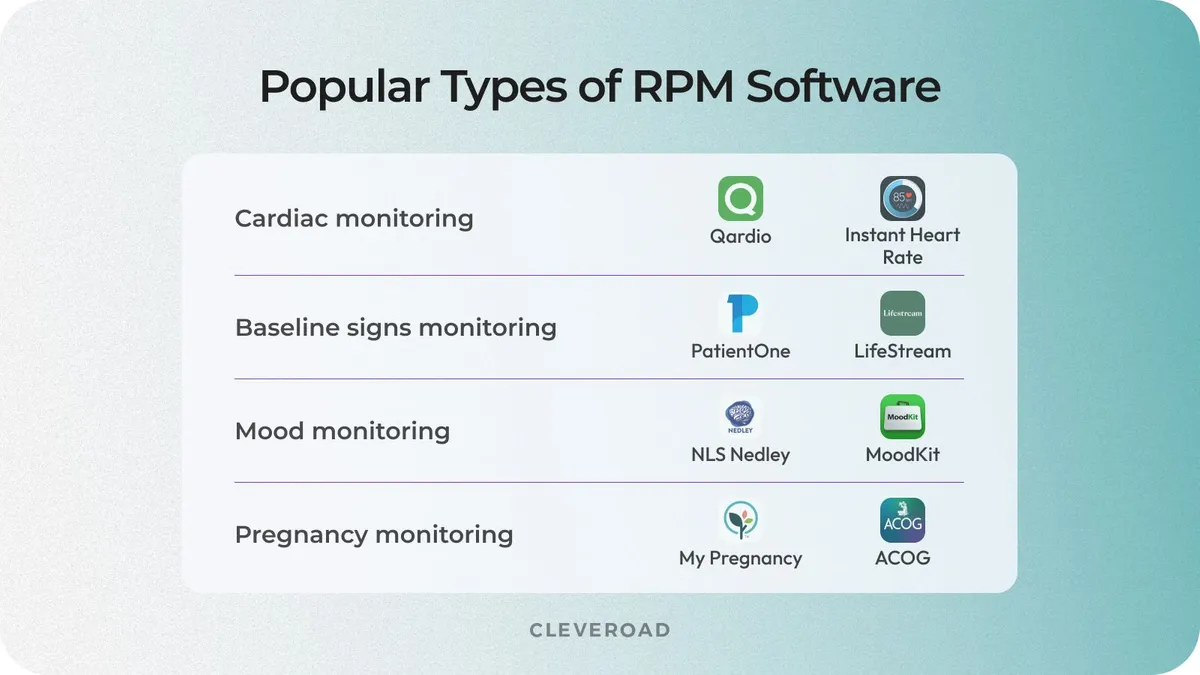
Types of remote patient monitoring solutions according to the purpose
Remote Patient Monitoring Software: Essential Components
Before remote patient monitoring development, you should be aware of its key components. Commonly, there are four significant elements of RPM solutions we'll describe below.
Remote patient monitoring devices
Modern medical tools and devices are the first components of remote patient monitoring platforms. They collect a wealth of health data, from heart rate to glucose level, without healthcare provider involvement. They can come in the form of implantable sensors or manageable wearables like an Apple Watch.
But, according to FDA requirements, only wireless, noninvasive devices tracking general physiological parameters are allowed for their use by clinics remotely. It includes electronic thermometers, cardiac monitors, apnea monitors, electrocardiographs, etc. In addition, all the IoT-based medical devices require a dedicated mobile app to transfer patient data to healthcare practitioners.
Patient-side mobile app
Remote patient monitoring app development ensures direct “patient-device” communication for further medical providers’ analysis. A patient's mobile device has to meet a row of criteria, such as:
- Support Bluetooth Low Energy (BLE) to interact with IoT medical devices.(Since 2012, almost all smartphones support both Classic Bluetooth and BLE. BLE is also supported by most Windows, Linux, and Mac devices.)
- Comply with IEC 62304 safety standards that define medical app development and software requirements within medical devices.
- Follow FHIR industry standards to ensure digital product interoperability.
- Maintain advanced levels of security for protected health information (PHI) and comply with HIPAA regulations.
To improve patient engagement, the RPM mobile app development usually include informative visualizations for provided data, access to educational materials, medical questionnaires, drug reminders, and doctor-patient communication tools (video, audio, or chat).
Cloud data storage
Commonly, cloud databases obtain raw patient-created information from smartphones. However, some remote patient monitoring solutions provide direct-to-cloud connectivity for healthcare IoT devices. In this case, all the generated data is stored in the cloud, and there is no need to download a dedicated mobile app. You can integrate blockchain in cloud computing to reduce data loss cases and eliminate security concerns. Adopting blockchain technology will provide an extra security layer for patient data through end-to-end encryption and advanced database protection.
Hospital-side application
The final crucial component of remote patient monitoring solutions is hospital-side software. Similar to a patient application, it must be HIPAA (or GDPR) compliant and follow medical devices interoperability rules. Also, the RPM web platform should be incorporated with the clinic's EMR system (via FHIR-based API) to exchange critical data and prevent developing data silos.
On the hospital side, patient monitoring software should include the following modules:
- Decision support module. It allows for the automated comparison of data obtained from the patient to the threshold values set by the medical provider. If the limits are exceeded, this information is sent to the notification center.
- Notification module. This module aims to process warning messages once the support module detects that threshold values have been exceeded. If they are, the doctors are notified of abnormal conditions via SMS, email, or in-app notification.
- Report module. This module collects all the measurements and manual inputs, forms them into appropriate reports, and sends them to a doctor.
- Analytics module. This is one of the main parts of remote patient monitoring app development for doctors. It relies on BI tools and data visualization methods to display measurements in real-time along with behavioral patterns and trends. It allows physicians to forecast risky events and make well-informed therapy decisions.
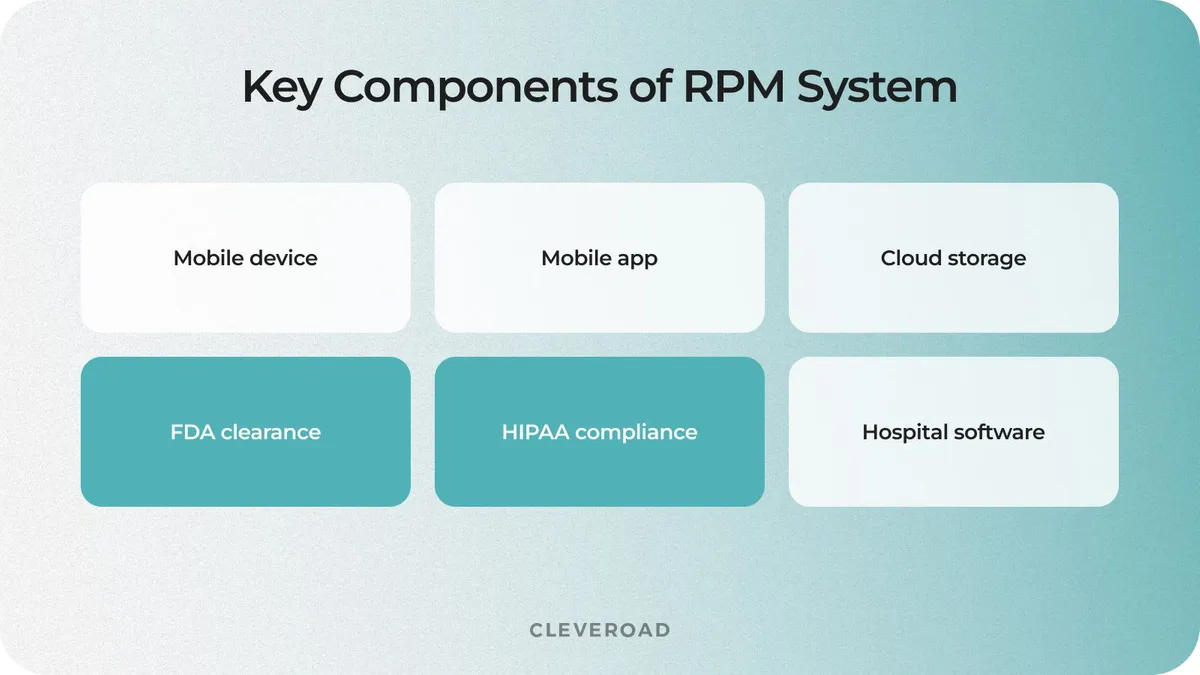
Key components of RPM apps
5 Best Examples of Remote Patient Monitoring Solutions On the Market
Let's observe the list of the best remote patient monitoring software development examples. The following range may provide you with some ideas to apply to your own telehealth project.
Dexcom
Dexcom is a remote patient monitoring platform to monitor blood glucose. It offers a complete system, hardware, and software for remote patient monitoring. The Dexcom G6 CGM system comprises a wearable sensor and transmitter to transfer glucose numbers to a smart device. The solution allows patients to share their data with up to 10 people, so that they can inform their family members of their status. The Dexcom platform shares data with the healthcare providers monitoring the patient. It tracks trends in blood glucose gleaned from the IoT-based device and submits patients’ visual data analysis. Physicians (clinics) can employ this information to customize a patient's treatment plan.
Medtronic
Medtronic is a full-range remote patient monitoring software. It has patient-facing apps (both for iOS and Android devices), which link to wearable devices that track vital signs and other health indicators (e.g., weight, glucose level, blood pressure, etc.). Clinics can scrutinize the data with the help of the Medtronic Care Management Services platform. Healthcare providers are alerted if the patient’s health indicators have exceeded the defined level so they can analyze trends and adjust the patient's care plan based on data obtained.
CoachCare
CoachCare powers healthcare establishments with virtual health and remote patient monitoring software corresponding to each case's unique clinic workflow and protocol. The platform gives physicians access to relevant patient health data to improve treatment decision-making. CoachCare's distinctive feature is insurance functionality that brings added business value. It allows medical providers to earn up to 11.2x ROI through reimbursements while reducing the overall price of care.
Breaking down how to develop a telemedicine app in our full guide. Check it out!
Health recovery solutions
The Health Recovery Solutions is a disease-specific software integrated with wireless Bluetooth devices for vital monitoring. This remote patient monitoring software focuses on engaging and changing patients' behavior to improve clinical outcomes. The platform supports more than 80 conditions with biometric monitoring, virtual visits, symptom screening, and prescription management tools. HRS grants advanced EMR integrations, clinical and reimbursement expertise, and round-the -clock technical support. Apart from patient monitoring itself, it also serves as an educational platform, where patients can find health-related content to enhance their wellness awareness and knowledge.
Philips
This patient monitoring system software is a network of the dashboard for medical providers and a companion mobile app for patients. It captures a steady stream of patients’ data from monitors and connected devices then sends it automatically to your EMR. For instance, a user can connect their blood glucose meter to upload information, as well as enter their temperature. Mobile apps allow physicians to personalize patients' treatment plans and coordinate therapy with other medical providers. In addition, Philips software taps the power of advanced clinical decision tools to assist in revealing a set of critical events like sepsis and pneumonia so that doctors can make informed care decisions.
Even though there are many remote patient monitoring solutions on the market, it’s better to focus on custom medical software development. This way, you will be ensured that you get a unique medical solution highly adaptable to your business processes.
How to Implement the Patient Monitoring Software Platform In Your Business Processes
The proper implementation of a remote patient monitoring platform is key to the success of your company's activity. We've prepared the appropriate points you should consider before RPM mobile app development:
Robust patient data security
As a healthcare service provider, you deal with a wealth of sensitive user data. Considering the ever-rising cyber attacks, it’s vital to undertake all the preventive measures to safeguard your patient monitoring system software. Moreover, online payments through the app for consultation are also part and parcel of the functionality.
Thus, you need to implement a robust security system to ensure high-level data protection. Overlooking decisive security actions may result not only in financial losses but also concerns with the law. Fortunately, there are many telemedicine tools, frameworks, and protocols at your disposal.
Here are some security arrangements to consider:
- Compliance with legal and privacy regulations. Ensure your remote patient monitoring apps keep up with country-specific regulatory standards like HIPAA, GDPR.
- End-to-end encryption. Encrypt your data to prevent data loss from happening. The most popular standards for delivering remote patient monitoring solutions are AES 128, 192, or 256-bit encryption, OpenPGP, and S/MIME.
- MFA protection. Consider multi-factor authentication to access the private users’ details.
- Modernization of legacy systems. Ensure incorporated security software is constantly upgraded and keeps up with modern requirements.
- Cybersecurity frameworks. Healthcare cybersecurity frameworks assist organizations in operating sensitive data and predicting cybersecurity risks due to their adaptive approach. The most common frameworks examples are NIST, HITRUST, and ISO 27000 Series.
Country-specific regulatory compliances
The region your patient monitoring system software is designed for defines which regulations and guidelines your app must comply with. The type of data it involves and processes, for which period and the entire product concept also impact the medical standards applied. There are no all-in-one law regulations. Depending on the country and/or under certain conditions, your patient monitoring software must respond to the set of laws and regulations, such as HIPAA (United States), PIPEDA (Canada), and General Data Protection Directive (Europe), etc. Therefore, you should become acquainted with the required laws before deploying your telehealth project.
Custom RPM app from domain experts
Tell us project details, and we'll help you deliver RPM system to comply with industry regulations
Interoperability
Healthcare app development implies integrating with different wearable devices to monitor patients' well-being and accumulate a great amount of users' data for better treatment planning. That's why medical device interoperability is essential. It allows for safe and automatic data transfer among various devices and software solutions. Creating a remote patient monitoring software development may demand integration with your established medical systems or devices you use. Using healthcare APIs will enable smooth and effective communication between all the interlinked systems.
Current data analysis
Remote patient monitoring development involve processing and analyzing data obtained from smartphones, smart watches, smart bracelets, and other connected sensors and wearable devices. Collected, structured, and scrutinized information is vital for diagnosis and patients’ treatment with chronic illnesses (such as diabetes) as well as controlling and assistance of seniors. For successful custom RPM mobile app development, data must be gathered safely and integrated correctly into your company’s existing data management system. This will enable better data analysis preventing severe health issues from happening.
Requirements collection
This stage implies assembling a list of required features, third-party services, and platforms to use. But, before collecting the requirements and determining product specifications, thorough research is needed. This entails:
- Division of patients on category. For instance, people with chronic diseases and children would need different features in remote patient monitoring app development
- Defining objectives for stakeholders (investors, doctors, and medical staff). For instance, endocrinologists may require a remote patient monitoring platform just for diabetes management, while a geriatrician may select a platform that connects with multiple medical devices
- Analyzing existing remote patient monitoring solutions on the market to see what customers expect from RPM systems
- Discover needed certification & regulatory compliance to successful patient monitoring software
If you experience difficulties preparing project requirements, Cleveroad experts will take off the research stage and help you select the needed functionality (and the right technology stack) as to ROI expectations. Our solution team which includes business development manager, solution architect, business analyst and UI/UX designer will scrutinize your business goals and requirements and advise which features to implement first (for a faster launch). Our team will also provide you with personalized project estimation and visual concepts of your own remote patient monitoring platform.
Development and Integration
At this stage, a team of software engineers turns the product’s design and architecture into a functional app according to approved requirements. However, if you want to optimize costs, developers can work under your control according to your demands. Remote patient monitoring solutions comprise several products: a web platform for medical personnel, mobile apps for patients, and software solution for integrating wearable devices with the system. Therefore, it's critical to ensure the interaction of all these elements to come up with an interoperable system.
At Cleveroad, we follow the Agile SDLC methodology to deliver a top-quality remote patient monitoring platform in the shortest time. According to this model, the development process is divided into sprints (two-week periods), and each sprint goes through iterations until the small portions of the app are completed. This approach allows us to quickly respond to dynamic-changing project requirements without disrupting the entire workflow and the final app’s quality.
After remote patient monitoring software is built, it should be integrated with key medical management systems and tools, such as:
- Telemedicine software development
- Electronic Medical Records Software, or EMR (Before doing that know more what is EMR integration)
- Patient portal development
Merging different types of software parts or subsystems will allow you to obtain an entire patient records report by collecting and analyzing data from all the monitors and devices.
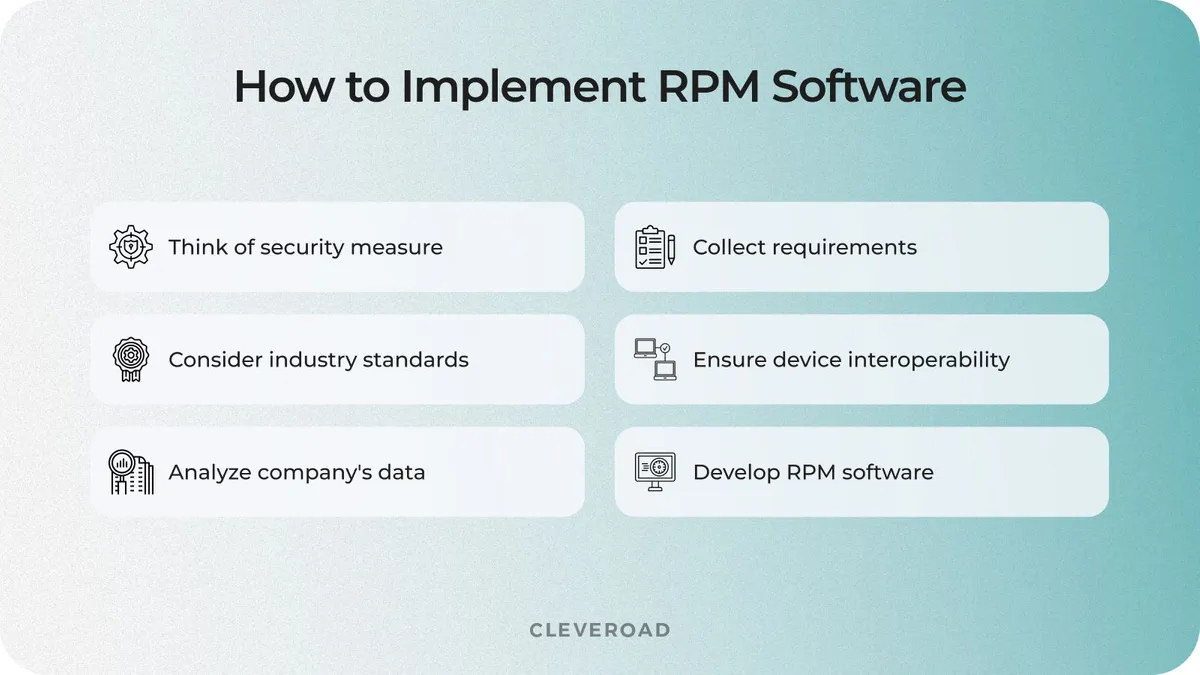
How to implement remote patient monitoring software
Patient Monitoring Software From Cleveroad
Cleveroad is a healthcare mobile and web development outsourcing company based in CEE region with 10+ years of experience in delivering custom digital solutions and/or modernizing the existing ones in multiple domains, among which the Healthcare industry takes the leading position.
Our team has hands-on experience creating EMR, ERX, patient portals, remote patient monitoring software, and other bespoke solutions to improve personalized care, reduce operational costs, and bring users' experience to new heights. We start our cooperation with an in-depth audit of the company's business to provide a telehealth solution aligning your unique business needs.
By cooperating with us, you’ll get:
- A broad scope of healthcare IT services, including home patient app creation, medical IT consulting, IoT software engineering, medical IT support, etc.
- Creating healthcare software solutions complying with HIPAA, HITECH, PIPEDA, and GDPR.
- Delivering home patient software systems following industry regulatory requirements, such as FDA and ISO.
- On-demand services: IT infrastructure monitoring, cybersecurity, cloud migration, legacy system modernization, etc.
- A thorough consultation with our Solution Architect as to the healthcare and telemedicine projects deployment.
- All-out Project Management Office to manage multi-tier medical projects.
- Signing Non-Disclosure Agreements (NDA) per your request.
To illustrate our expertise in practice, let us introduce our latest case for athlets, fitness, military and also for endocrinologists, nutritionists and others — an IoT-based system that track the hydration level in a human organism and allows to control it for medical and wellness purposes.
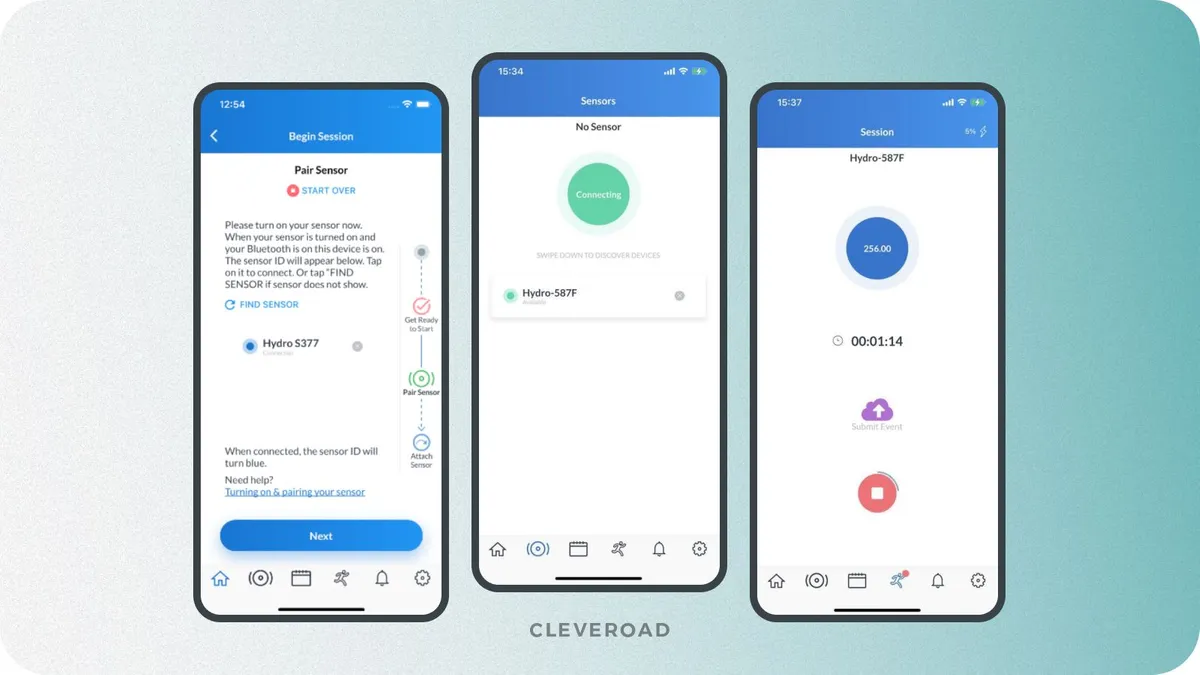
Example of interface for remote monitoring of users' hydration indicators built by Cleveroad
Our team of 14 members was challenged to:
- Create a solution enabling users to monitor hydration levels from any mobile device
- Ensure integration with the customer’s PaaS (Product-as-a-Service) platform and compliance with the 510(k) FDA Medical Device Registration
- Provide solution with constant support and maintenance so that the customer can expand the existing network of partner organizations
Hydrostasis should become a holistic system, easy to use and uitable for affiliate campaigns.
How we did it:
We’ve created cross-plaform Flutter app connected with IoT hydration sensor. Also, there was built a web-based admin panel. To develop this custom solution we’ve completed a deep analysis of the customer’s business processes and solution functionality to cover FDA requirements. After the software system was deployed, we’ve provided our customer with PaaS support, maintenance, and improvement on-demand.
Results obtained:
Our client received the holistic system integrated with an IoT sensor and their PaaS, long-term collaboration with technical support and updates. Also, the customer has launched a partnership campaign which allows them to expand the area of presence.
Make the most out of remote patient monitoring solutions by benefiting from our hands-on experience. You’ll get a sought-after RPM software, allowing you to increase your business performance by automating the care delivery process and streamlining communication between medical providers and patients.
Get expert assistance in building RPM system
Receive our remote monitoring software development services to get intuitive software for traditional and virtual care via remote monitoring
To successfully implement your remote patient monitoring software, ensure:
- Robust data security
- Alignment with country-specific regulations
- Interoperability
- Current data analysis
- Precise requirements collection
- Smooth development and integration
Remote patient monitoring refers to the use of specific technologies and practices assisting medical providers in controlling real-time changes in a patient’s health data distantly and using it to personalize a treatment plan.
Remote patient monitoring can be profitable due to cost savings, improved efficiency, revenue generation, better patient outcomes, and the growing market demand for RPM technology and services.
- Division of patients on category. For instance, people with chronic diseases and children would need different features in remote patient monitoring app development.
- Defining objectives for stakeholders (investors, doctors, and medical staff).
- Analyzing existing remote patient monitoring solutions on the market to see what customers expect from RPM systems.
- Discover needed certification & regulatory compliance to successful patient monitoring software.

Evgeniy Altynpara is a CTO and member of the Forbes Councils’ community of tech professionals. He is an expert in software development and technological entrepreneurship and has 10+years of experience in digital transformation consulting in Healthcare, FinTech, Supply Chain and Logistics
Give us your impressions about this article
Give us your impressions about this article
